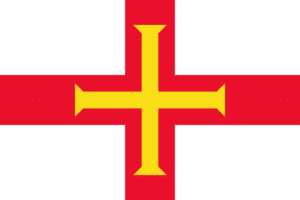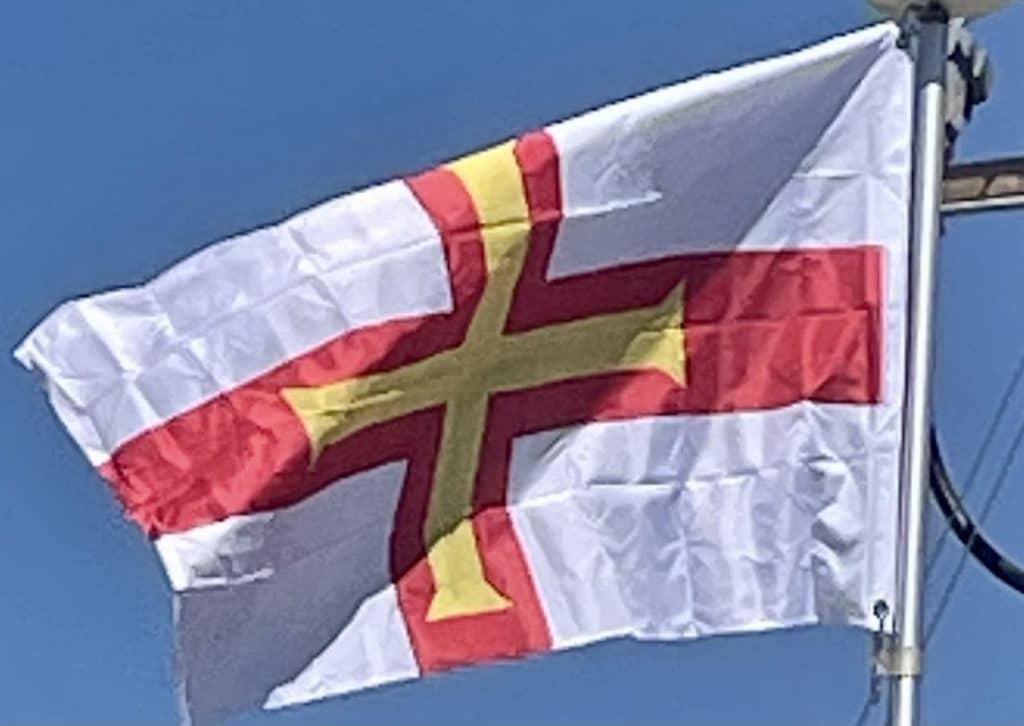A narrow gauge railway was built by the German forces during WW2 to transport materials used in the construction of coastal defenses. This was removed after the War.
Guernsey has a public bus service, operated by CT Plus on behalf of the States of Guernsey Environment and Infrastructure Department.
Flag of Guernsey:
The flag of Guernsey was adopted in 1985 and consists of the red Saint George’s Cross with an additional gold Norman cross within it. The creation was prompted by confusion at international sporting events over competitors from Guernsey and England using the same flag. It was designed by the Guernsey Flag Investigation Committee led by Deputy Bailiff Sir Graham Dorey. The flag was first unveiled on the island on 15 February 1985. The gold cross represents William the Bastard, Duke of Normandy (who became, after the conquest, William I of England). William purportedly was given such a cross by Pope Alexander II and flew it on his standard in the Battle of Hastings. Since 2000, a red ensign with the cross in the fly has been used as the government’s civil ensign and as a blue ensign.

Prior to 1985, Guernsey had no official unique flag and instead used the St George’s Cross (the flag of England) as its flag when one was officially required. This came about after King Edward VIII granted consent for Guernsey to use the flag of England in 1936; during the German occupation of the Channel Islands, the residents were prevented from displaying official British symbols, but the flag of England was permitted for civilian use. The Government of Guernsey carried out official studies in 1906 and 1935 to determine any unique and identifiable historical flags that Guernsey could use to represent it. In 1983, the Bailiff of Guernsey argued the need for a new flag for Guernsey because of the confusion caused by using the flag of England. The impetus for the flag’s creation was confusion at the 1982 Commonwealth Games, where Guernsey competed under the flag of England–some other nations’ competitors erroneously believed England was entering two teams into the Games.
Research was carried out by Deputy Bailiff Sir Graham Dorey, of Guernsey’s Flag Investigation Committee. The committee considered a number of designs. It was initially considered that the new flag for Guernsey should contain green, but it was ruled that the color green has no historical basis in Guernsey aside of being used as a sporting colour by the Guernsey national football team in Muratti matches. Consideration was given to using the coat of arms of Guernsey on a St George’s Cross but this was rejected on the grounds that the arms would be unidentifiable at a distance. It was also decided that to do so would be to focus on English symbols, not recognizing Guernsey’s independence or Norman history. The committee eventually settled on including a gold cross on top of the St George’s Cross. The gold cross was chosen as it was a symbol of King William the Conqueror, seen on a banner at the Battle of Hastings, as portrayed on the Bayeux Tapestry. That banner was purportedly given to William by Pope Alexander II as a symbol of his blessing for the Norman Conquest of England along with a request for the clergy of the Church of England to give way to William. The new flag’s design was to symbolize that the islanders were of Norman descent but loyal to the English (and later British) Crown. In 1985 Queen Elizabeth II, Duke of Normandy, granted a Royal Warrant for the flag to become the official flag of Guernsey. Unveiled on 15 February 1985, the flag was flown for the first time on Liberation Day on 9 May, the 40th anniversary of the Channel Islands‘ liberation from German occupation during the Second World War.[6]
